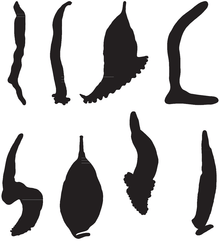Polyopisthocotylea
Polyopisthocotylea is a subclass of parasitic flatworms in the class Monogenea. [1][2][3]
| Polyopisthocotylea | |
|---|---|
 | |
| Silhouettes of bodies of various polyopisthocotylean Monogeneans | |
| Scientific classification | |
| Kingdom: | |
| Phylum: | |
| Class: | |
| Subclass: | Polyopisthocotylea |
| Orders | |
|
See text | |
Classification
There are only two subclasses in the class Monogenea:
- Monopisthocotylea. The name means "a single posterior sucker" - the attachment organ (the haptor) is simple.
- Polyopisthocotylea. The name means "several posterior suckers" - the attachment organ (the haptor) is complex, with several clamps or suckers.
The subclass Polyopisthocotylea contains the four following orders:[1]
- Order Chimaericolidea
- Order Diclybothriidea
- Order Mazocraeidea
- Order Polystomatidea
Examples of species
- Microcotyle visa, one of the numerous species which are parasitic on gills of marine fish.
- Diplozoon paradoxum, famous for its perfect monogamy, with the two individuals of the pair fused together
- Lethacotyle vera, a parasite of the brassy trevally (Caranx papuensis), "the monogenean which lost its clamps"
- Polystoma integerrimum, a parasite of frogs which synchronises its breeding with that of its host
- Protocotyle euzetmaillardi, a parasite of the bigeyed sixgill shark Hexanchus nakamurai
- Chimaericola leptogaster, a parasite of the gills of the chimaera Chimaera monstrosa.
gollark: Technically, by weight, it's probably mostly metal casings and then the weird fibreglass stuff PCBs are made from.
gollark: (I plan to maybe switch over to an RK3588 SBC of some kind when they come out though. Basically the same performance on way less power. Very impressive.)
gollark: My own server is a generation behind that, and that was just randomly lying around for free?
gollark: In general.
gollark: A few weeks ago someone on Hackaday apparently had a VAST quantity of batteryless Windows tablets and I wanted some of them for things, but nooooooo, it costs *money* to ship things.
References
- WoRMS (2019). Polyopisthocotylea. Accessed at: http://www.marinespecies.org/aphia.php?p=taxdetails&id=119220 on 2019-02-08
- Yamaguti, S. (1963). Systema Helminthum Volume IV Monogenea and Aspidocotylea: John Wiley & Sons.
- Hayward, C. (2005). Monogenea Polyopisthocotylea (ectoparasitic flukes). In K. Rohde (Ed.), Marine Parasitology (pp. 55-63): CSIRO, Collingwood, Australia & CABI, Oxon, UK.
External links
This article is issued from Wikipedia. The text is licensed under Creative Commons - Attribution - Sharealike. Additional terms may apply for the media files.